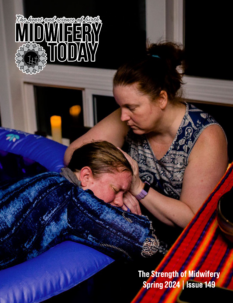
Biological Nurturing: The Laid-back Breastfeeding Revolution
Editor’s note: This article first appeared in Midwifery Today, Issue 101, Spring 2012.
Subscribe to Midwifery Today Magazine
Biological nurturing (BN) is a new neurobehavioral approach to breastfeeding initiation that aims to reduce latching problems and early unintended breastfeeding cessation. In biological nurturing, mothers lean back and place the baby on top so that every part of the baby’s body is facing, touching, and closely applied to one of the mother’s curves or to part of the surrounding environment. Nursing in a laid-back position opens the mother’s body, which promotes neonatal locomotion by releasing up to 20 primitive neonatal reflexes which act as breastfeeding stimulants (Colson et al. 2008). BN is quick and easy to do; there is no lining up of body parts and no “correct” breastfeeding procedures. Instead, mothers hold their babies for as long, as often, and in as much skin-to-skin contact as they want—even when the baby is not hungry or feeding. That introduces some subtle changes. BN is not just about breastfeeding; rather the approach in itself encourages mothers to keep the baby in the right place, what Nils Bergman (2008) calls the mammalian habitat. It is therefore not surprising that many mothers say BN helps them get to know their baby sooner. The laid-back postures are not only ideal to promote maternal comfort, but they also naturally lead to that fascinating “en-face” mother-baby conversation first documented by Klaus and Kennel (1976). During BN, mother’s shoulders, neck, and head are supported while they gaze, groom, and coo at their newborn. Each baby’s unique behavioral response is usually the only breastfeeding instruction a mother needs.
Biological nurturing also has advantages for health care providers. For instance, it saves time, as routine instruction of breastfeeding skills becomes unnecessary. Furthermore, BN is anchored in the qualitative presence of inborn baby reflexes that have always been used to assess nervous function (Peiper 1963; Prechtl 1977; Amiel-Tison and Nugent 1984; Brazelton and Nugent 1995; Dubowitz et al. 1999). Building upon their medical evaluations, the BN professional assessment also acts as a screening test, helping midwives, lactation consultants, and other health care providers detect any neonatal neurological problems sooner.
Even though I often call BN a new approach, the laid-back component central to the concept is not really new. Mothers who enjoy breastfeeding have always varied the degree of their body slope in certain environments such as the privacy of their own home or in public when the furniture and general setting is appropriate. However, many do not realize that they are nursing in a semi-reclined posture. This may be because breastfeeding whilst lying back has been frowned upon in mainstream literature and culture. Biological nurturing is much more than a feeding posture, and my research findings offer evidence-based explanations for how the components of BN interact to aid breastfeeding initiation. Practically speaking, that means health care providers now have research data to back up suggestions to use the laid-back approach as an alternative, and maybe a more species specific way, to breastfeed (Colson 2010). This has resulted in an explosion of people using BN—a real laid-back breastfeeding revolution!
Mothers and health care providers alike write me with questions. Sometimes they ask why we need a new breastfeeding vocabulary, but most of the time they request a better understanding of the idea behind BN, its components, and how to apply the laid-back mechanisms clinically. This article clarifies these questions, beginning with the concept and then introducing the role played by primitive neonatal reflexes to discuss how and why BN works to overcome latch refusal. Finally, I will touch upon the need for new words and will conclude by exploring the breastfeeding relationship—the essence of biological nurturing.
What Is Biological Nurturing?
Biological nurturing is a mother-centered approach and the words are purposefully abstract, prompting mothers to give it meaning. Nevertheless, BN brings together a range of optimal mother-baby breastfeeding positions, states, and behaviors. By definition, these variables change from mother to mother, from baby to baby, and from feed to feed. The six components of biological nurturing (mother postures, baby positions, neonatal state, maternal hormonal state or complexion, primitive neonatal reflexes, and innate maternal breastfeeding behaviors) interrelate constantly, producing changes even during the same feed.
As soon as baby lies prone on top of mom’s gentle body slope, gravity keeps their bodies together. Any movement causes his body to brush against his mother’s, and these positional interactions appear to release spontaneous or innate mother-baby feeding behaviors. The comfort and freedom of breastfeeding positions inherent in BN are relatively new. Traditionally, expert professional consensus has discouraged mothers from leaning back to breastfeed. Circa 1985, health care providers taught mothers to sit upright or lie on their sides. Pictures portraying mothers leaning back were often covered by a large X or other symbol suggesting that the laid-back posture was incorrect (RCM 1988, 2002; Renfrew, Fisher and Arms 1990, 2004). However, no research data supported the routine use of the “correct” upright and side-lying positions proposed. Speculations often accompanied the X-marked pictures expressing fears about mastitis and untested theories concerning erroneous ways mother’s breasts might hang in the laid-back postures (RCM 1988, 2002). The mainstream breastfeeding literature has recently introduced biological nurturing (Mohrbacher 2010; LLL 2010; Genna Watson 2010). Nevertheless, we can still find breastfeeding chapters in UK midwifery textbooks promoting upright and side-lying positions and underpinned by unfounded beliefs (Ackerman 2010). Although the promotion of skin-to-skin contact has had a positive impact on labor ward routines, on a UK postnatal ward many mothers would not dare to breastfeed in a laid-back posture, as the following testimonial suggests:
My son was placed to my breast shortly after birth and fed for about 35 minutes, and it was fabulous. The midwife was very relaxed and simply placed him there and let him do his own thing, while I laid back and relaxed! I decided then and there that breastfeeding was definitely for me, but was very apprehensive as I had heard so many negative things regarding it, and I did not know anyone who had successfully breastfed for any length of time. I am certain that if my midwife had not been so natural and relaxed about the first feed, things would have been very different for me! I was moved to the postnatal ward a few hours after the birth. It was horrendous. Nurses stood guard and scrutinized every move I made breast-wise! It was here that I heard the mantra “tummy to mummy, nipple to nose” spoken aloud. I had read about it before but didn’t realize it was almost treated as the law! I hate those words now; I found myself repeating them in my head and didn’t dare deviate. I was also told to sit bolt upright. I was intimidated when a lineup of three nurses stood in front of me, watching me try to force my baby to latch on. They said I couldn’t go home until I could manage to feed him, but I just wanted to be out of there. I tried to let him find his way to the nipple and was immediately berated for it.
Now you can see why I would have appreciated being told that there are alternative ways to breastfeed. The hospital staff was obsessed with breastfeeding without seeming to offer any practical advice except for the instructions printed in the government leaflets. I have learned now that, as a mother, your instincts can be trusted and that your baby is well-equipped to feed himself if given the chance. I just needed someone to tell me this at the time.
The origins, background and development of BN through clinical practice and several research projects are explained in my book, An Introduction to Biological Nurturing: New Angles on Breastfeeding. The following paragraphs, some of which are extracted from my book, explain how the 20 primitive neonatal reflexes (PNRs) that we described could either stimulate or thwart latch. Unexpectedly, mothers’ laid-back postures were central to the expression of the reflexes as breastfeeding stimulants. This leads us first to explore these unforeseen findings and then to introduce reflex theory as a way to overcome latch refusal.
The Role of Primitive Neonatal Reflexes (PNRs)
Rooting and sucking are well-known feeding reflexes, yet few researchers have studied other PNRs in the feeding context. That was the subject of my doctoral study. I examined and compared biological nurturing positions with traditional ones to discover if other PNRs had a role to play. My research was supported by rigorous scientific scrutiny; I was supervised by a panel of academic and clinical experts including two neonatologists, a lactation consultant, a cranial osteopath and a La Leche League peer supporter. We never imagined that PNRs could have a negative role in the feeding context. Yet time and again, we saw reflexes pushing the baby away from the breast such as jerky movements like head shaking, leg scrambling, body flinging, arm thrashing, fighting, scratching and leg-cycling movements that looked like kicking. We never anticipated such commotion. On the other hand, we sometimes observed these same movements as smooth and coordinated, helping the baby find the breast, latch on, and feed. The same reflexes appeared to either thwart feeding attempts or stimulate successful latch.
The bipolar nature of these reflexes caught us by surprise, as the two traditional PNRs have always been viewed as feeding aids. At the same time, during data analysis, the mother’s breastfeeding position emerged as unquestionably the single most important variable—either releasing the reflexes as breastfeeding stimulants or barriers. Results clearly demonstrated a statistically significant difference: More reflexes were released as stimulants when mothers lay back than when they sat upright or lay on their sides. This important finding has clinical implications, particularly in cases where babies refuse to latch onto the breast.
Latch and Suck Failure
Quinquennial UK feeding surveys characterize latch failure either as “fighting the breast” or as “breast refusal,” where a baby who should be hungry is either too sleepy to latch or fails to suck (Bolling et al. 2007; Foster et al. 1997; Hamlyn et al. 2002; Martin and White 1987; White, Freeth and O’Brien 1992). Consecutive surveys clearly show that more mothers stop breastfeeding during the first postnatal week because of latch/suck failure than any other problem. They also demonstrate a trend: a steady quinquennial increase in the number of mothers who wean prematurely due to latch/suck failure (from 24% in 1985 to 35% in 2005). However, few clinicians describe objectively the specific behaviors associated with latch and suck failure. Objective description comprises what clinicians can see or hear. Gohil (2006) is the exception, offering a vivid account of what he calls a new breastfeeding behavior observed during engorgement. Termed “breast boxing,” he describes some PNR-like movements associated with latch failure that we saw time and again in my study. Gohil (2006) writes, “It was observed that the infant does not suckle and pushes himself away with his fisted hands at the breasts or abdomen of the mother, and kicks away at the mother’s abdomen and avoids feeding.”
My data suggest that these kicking and pushing away behaviors were often combined with increasingly frenetic activity and to-and-fro horizontal head shaking that thwarted latch. Typically, the baby was in a quiet alert state at the start of the feed, in skin-to-skin contact, or lightly dressed. After about a minute and unable to latch, side-to-side head rooting movements increased in frequency and intensity. These movements were often accompanied by the hand-to-mouth reflex, where the hungry baby appeared to prefer sucking on his fist instead of the breast.
The Baby Friendly Initiative (BFI), a global World Health Organization effort to promote and support breastfeeding, also recorded these behavioral phenomena and suggested that mothers think that the head shaking means the baby is “saying no” to breastfeeding (WHO 1997). During the first videotaped episode in my study, over half of the breastfed babies displayed these negative behaviors, preventing them from latching. Mothers often feared breast rejection. They said the baby did not like breastfeeding. The BFI is quick to reassure that contrary to maternal interpretation, this is normal behavior, and I understand both perspectives. Rooting can be characterized by a range of movements from slight lip twitches to exaggerated side-to-side head turning. Together with the hand-to-mouth reflex and arm and leg cycling, these are an integral part of the normal behavioral repertoire of the neonate. However, like some mothers, we observed systematically that in certain positions, these inborn movements were obstructive and we agreed that this was due to the effects of gravity. It was as if gravitational forces were pulling mothers and babies apart, dragging the baby out and down toward the pillow or the mother’s lap. Gravity appeared to override what might be considered the normal stimulatory nature of the reflex response in the feeding context.
How Does Position Affect the Expression of the Reflexes?
The mothers who experienced the PNRs as barriers were in skin-to-skin contact or lightly dressed and were lying on their sides, sitting straight upright or leaning slightly forward. Upright mothers often placed the baby on a pillow in front of and at right angles to their bodies, and although the baby was turned toward his mother, there was usually a gap or angle between their bodies. The baby’s thighs, calves, and feet were often in contact with thin air. Importantly, mothers had to hold their babies by applying pressure along baby’s back to keep him at breast level and close enough to feed. I have termed this latter positional phenomenon “dorsal feeding.” The more the mother struggled to elicit mouth gape, leading in with the chin, the tighter she gripped the baby’s back. This firm grip often extended to the baby’s neck or head. The firmer the grip, the more the baby struggled with frantic arm and/or leg cycling PNRs, increasing in strength and amplitude as he worked himself up to a crying state.
Dorsal Feeding
Peiper (1963) compares feeding positions across species, assuming that the human baby is an obligate dorsal feeder (where mothers must physically hold their babies’ back). In fact, we have always believed that our babies, unlike some of our mammalian cousins, should initiate feeding when cradled in arms. Have you ever noticed that in upright positions, putting the baby to the breast or bottle feeding always includes applying pressure along the baby’s back? Experts studying the mechanisms of upright postures have suggested that this maintains positional stability and keeps the baby close and at breast level. If you thumb through any mainstream breastfeeding book prior to 2010, you will see mothers sitting upright or side-lying, applying this back pressure in almost every picture.
A Mammalian Position
In contrast, my research comparing BN positions found that the range of human locomotion aiding latch was limited when mothers cradled their babies in the traditional holds. As soon as mothers leaned back, their babies moved towards those abdominal feeding positions also described by Peiper (1963). In the abdominal positions, another baby reflex was observed—a pendular head-bobbing movement. This appeared to be released from a fixed point in the baby’s spine, and was documented previously by Scheildt and Prechtl (1951) and by Peiper (1963). These vertical up and down head movements were noted to stimulate latch in non-human mammals such as puppies and hamsters, where the baby’s tummy hugs the ground when they feed. I called this neonatal position “frontal feeding” because our observations suggested that the contact extended beyond the abdomen. The entire frontal region of the body from sternum to pubis, comprising the chest area as well as the abdomen, was involved. Furthermore, in frontal positions, the baby’s thighs, calves, and feet tops were spontaneously applied either to the mother’s body or to a part of the environment (the bed, sofa, chair, bed clothes, etc.).
In BN frontal feeding positions, babies often latched on without help and this action frequently appeared smooth and easy. We also observed common points. First, mothers made themselves comfortable leaning back to varying degrees of body slope. Second, the baby was neither vertical nor parallel to the mother’s body. Rather, baby often positioned himself by lying longitudinally (up and down) or obliquely, on top of the mother. In other words, unlike some of the lower mammals, the human baby did not lie prone and flat; he was always slanted in what looked like a natural or physiological body tilt. This tilt was usually upward due to the gradient provided by the gentle maternal body slope. We interpreted this body tilt as a natural way to support neonatal respiration (Colson et al. 2008). Third, the baby often approached the breast as though searching, using the pendular head-bobbing reflex which involved the entire trigeminal area, not just the chin. Finally, mothers did not have to hold the baby; no back, neck, or head pressure was necessary to achieve positional stability or to maintain the baby close and at breast level. Instead, gravitational forces helped to keep the baby on the mother’s body. Gravity also appeared to apply a slight pressure, smoothing and coordinating the reflexes. During biological nurturing, the baby became an active participant, often self-attaching; the baby achieved his own positional stability.
Why Do We Need a New Vocabulary?
My study suggests that breastfeeding initiation has to do with releasing inborn baby reflexes and instinctive mothering behaviors. These are part of our genetic inheritance; they characterize the human capacity to breastfeed. The nature vs. nurture debate concerning how humans acquire bio-behaviors has been the subject of heated discussion. Most health care providers are convinced that breastfeeding is a part of “nurture”—a learned skill. Although Gunther (1955) states as fact that mothers lack breastfeeding instincts, I have been unable to locate any research data backing her claim. Like researchers in other disciplines, my work suggests a blend of nature and nurture—hence the term biological nurturing. If breastfeeding initiation is about triggering and conditioning baby reflexes, as the BN data suggest, then creating an environment that enables positional brushing releasing the baby reflexes becomes the priority. This highlights a need to reconsider some traditional routines, for example, teaching breastfeeding skills and defining the characteristics of the “correct” latch. When a mother follows instructions or tries to remember the parameters of a “correct” latch, it stimulates the neocortex or the thinking part of her brain. It is well-known that thinking inhibits spontaneity or the expression of innate behavior. Likewise, when a midwife intervenes, applying back, head, or neck pressure, attempting to latch or force a reluctant baby to take the breast, a mother can feel helpless and stop breastfeeding—perpetuating that trend of premature weaning due to latch refusal. In contrast, releasing baby reflexes with BN promotes a synergy between mother and baby underpinned by a hormonal cocktail of innate behaviors that cannot be taught. BN is easy, non-invasive, and never involves force.
The term “laid-back breastfeeding” helps us to rethink aspects of current support strategies. Midwives have always believed that the maternal body is specifically designed for pregnancy and spontaneous birth. The double entendre in laid-back breastfeeding suggests that we can be relaxed and confident after the birth as well. When mom takes the lead doing BN in the human mammalian habitat, breastfeeding is no longer a rational choice. Instead it is part of a biological imperative that enables mom to personalize her experience. Breastfeeding becomes a normal activity of daily living with no steps or procedures to follow.
From a physiological perspective, mothers are constantly multi-tasking—breastfeeding whilst they eat and drink, walk, socialize, or work inside or outside the home. Biological nurturing brings out that everyday relationship that lies within the act. The term “relationship” implies the public and private give and take between two people. In other activities of daily living, mothers guide and protect their babies, and breastfeeding is not different. Like any relationship, there is a mix of innate and learned behaviors. However, for many years, breastfeeding as an acquired skill has revolved around procedures and techniques. The nurturing approach has dominated our understanding. Nurturing focuses attention on hospital policies and relies upon specific steps to success and instructions that do not work for all mothers. Biological nurturing restores balance. The new terminology acknowledges the importance of culture, policy, and environment whilst making a powerful argument for the nature or innate component of breastfeeding. This is the essence of the BN concept that has unleashed a veritable laid-back breastfeeding revolution.
References:
- Ackerman, B. 2011. “Infant Feeding.” In Maye’s Midwifery, 14th ed, edited by S MacDonald and J Mcgill-Cuerden, 624–26. Elsevier: Bailliere Tindall.
- Amiel-Tison, C, and A Grenier. 1984. La Surveillance Neurologique au cours de la Première Année de la Vie. Paris: Masson.
- Bergman, N. 2008. “Kangaroo Mother Care.” http://www.kangaroomothercare.com.
- Bolling, K, C Grant, B Hamlyn et al. 2007. Infant Feeding Survey 2005. London: The Information Centre.
- Brazelton, TB, and JK Nugent. 1995. Neonatal Behavioral Assessment Scale, 3rd ed. London: Mac Keith.
- Colson, S. 2010. An Introduction to Biological Nurturing, New Angles on Breastfeeding. Texas: Hale.
- Colson, S. 2010. “What happens to breastfeeding when mothers lie back?” Clinical Lactation, Inaugural Issue 1 (2010): 11–14.
- Colson, SD, J Meek and JM Hawdon. 2008. “Optimal positions triggering primitive neonatal reflexes stimulating breastfeeding.” Early Hum Dev 84 (7): 441–49. http://linkinghub.elsevier.com/retrieve/pii/S0378378207002423.
- Colson, S. 2006. “The Mechanisms of Biological Nurturing.” PhD diss., Canterbury Christ Church University.
- Colson, S, L DeRooy and J Hawdon. 2003. “Biological nurturing increases breastfeeding duration.” MIDIRS Midwifery Digest 13 (1): 92–97.
- Dubowitz, L, V Dubowitz and E Mercuri. 1999. The Neurological Assessment of the Preterm and the Full term Newborn Infant, 2nd ed. London: Mac Keith.
- Gohil, JR. 2006. “Boxing neonate on an engorged breast, a new behavior identified.” J Hum Lact 23 (3): 268–69.
- Gunther, M. 1955. “Instinct and the nursing couple.” Lancet 265 (6864): 575–78.
- Hamlyn, B, S Brooker, K Oleinikova et al. 2002. Infant Feeding 2000. London: TSO.
- Klaus, MH, and JH Kennel. 1976. Maternal-Infant Bonding, 1st American ed. St Louis, MI: Mosby.
- Martin, J, and J Monk. 1982. Infant feeding 1980. London: OPCS.
- Martin, J, and A White. 1987. Infant feeding 1985. London: OPCS.
- Mohrbacher, N. 2010. Breastfeeding Answers Made Simple. Texas: Hale.
- Mohrbacher, N, and K Kendall-Tackett. 2010. Breastfeeding Made Simple. California: New Harbinger.
- Peiper, A. 1963. Cerebral Function in Infancy and Childhood, 3rd ed. Translated by B Nagler and H Nagler. New York: Consultants Bureau.
- Prechtl, H. 1977. The Neurological Examination of the Full Term New Born Infant, 2nd ed. London: William Heinemann.
- Renfrew, M, C Fisher and S Arms. 1990. Breastfeeding: Getting Breastfeeding Right for You, 1st ed. Berkeley: Celestial Arts.
- Renfrew, M, C Fisher and S Arms. 2004. Breastfeeding: Getting Breastfeeding Right for You, 3rd ed. Berkeley: Celestial Arts.
- Royal College of Midwives. 1988. Successful Breastfeeding, 1st ed. London: RCM.
- Royal College of Midwives. 2002. Successful Breastfeeding, 3rd ed. London: Churchill Livingstone.
- Watson Genna, C. 2007. Support Sucking Skills in Breastfed Infants. Maine: Jones and Bartlett.
- White, A, S Freeth and M O’Brien. 1992. Infant feeding 1990. London: OPCS.
- Wiessinger, D, D West and T Pittman. 2010. The Womanly Art of Breastfeeding. Chicago: La Leche League International.
- World Health Organization. 1997. Breast-feeding Management: a Modular Course. London: WHO/UNICEF.


















